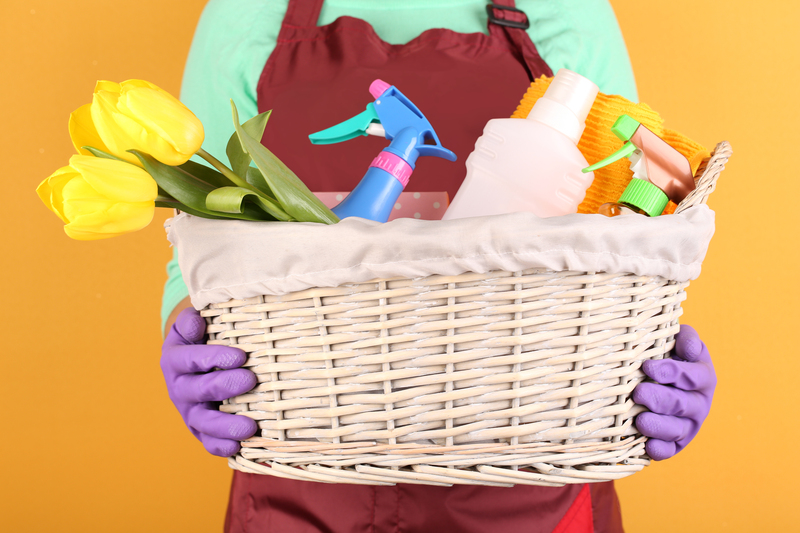Reclaim a Fresh Home Aroma by Conquering Pet Odors
Posted on 08/06/2025
Reclaim a Fresh Home Aroma by Conquering Pet Odors
Our beloved furry friends bring endless joy, loyalty, and companionship into our homes. Yet, pet odors can sometimes challenge even the most pristine housekeepers, leaving your living space less than inviting for guests and family members alike. If you yearn for a crisp, fresh home aroma and are determined to banish lingering scents, this comprehensive guide will empower you to conquer pesky pet smells. Read on for actionable tips, effective cleaning methods, and insightful advice to restore your home's delightful fragrance and maintain it for good.

Why Do Pet Odors Occur?
Before tackling the issue, it helps to understand what causes pet odors in your home. Common culprits include:
- Pet dander and fur: Microscopic skin flakes and loose fur get trapped in carpets, upholstery, and air filters, leading to a musty scent.
- Accidents and messes: Urine, feces, vomit, or saliva on carpets and floors permeate deep into fibers and padding.
- Poorly cleaned litter boxes or cages: Inadequate cleaning routines allow smells to intensify and escape into the home environment.
- Wet fur and outdoor smells: Pets returning from outdoors may bring in mud, dampness, or organic odors attached to their coats and paws.
Recognizing the source of unpleasant scents is the first step toward reclaiming that fresh home aroma and ensuring your efforts are effective.
Step One: Identify & Eliminate the Source
Pinpoint the Problem Areas
The most conventional cleaning routines may not be sufficient for persistent pet odors, as these smells often seep into porous surfaces. Begin with an inspection:
- Sniff out hotspots such as corners, behind furniture, and pet bedding.
- Use a UV blacklight for hidden urine stains--these glow under UV light and can often go unnoticed with the naked eye.
- Check your HVAC system, as ducts and filters can harbor hair and dander, redistributing scent throughout the home.
Address Pet Accidents Quickly
Whenever your pet has an accident:
- Blot the area immediately with paper towels or cloth--never rub, as this spreads the stain and odor.
- Use an enzyme cleaner, specifically designed to digest proteins and break down organic materials that typical cleaners can't handle. This effectively eliminates lingering scent markers that encourage repeat accidents.
- Rinse and dry thoroughly, ensuring all cleaning products are extracted to avoid sticky residues which can attract dirt.
Deep Clean for a Truly Fresh Home Aroma
Focus on High-Contact Surfaces
Your pets' favorite lounging spots are often the most significant odor contributors. Here's how to tackle them:
- Vacuum upholstery, carpets, and rugs at least twice a week using a high-efficiency particulate air (HEPA) filter vacuum. This captures fine particles and dander for improved air quality.
- Launder pet bedding, removable cushions, and slipcovers on the hottest water-safe setting weekly. Use odor-neutralizing detergents for optimal freshness.
- Steam clean carpets and upholstery every few months to eliminate deeply embedded odor molecules.
Pro Tip: Sprinkle baking soda liberally on carpets and let it sit overnight before vacuuming--its natural deodorizing powers will help absorb stubborn odors.
Hard Floors, Walls, and Baseboards
Don't neglect hard surfaces. While tile, wood, and laminate are less prone to trapping odor than carpet, residue from pet accidents or drool can linger:
- Use a diluted white vinegar solution to wipe down floors, walls, and baseboards. Vinegar neutralizes odors naturally and evaporates without residue.
- If your home has hardwood, ensure the vinegar is adequately diluted to prevent damaging the finish.
Litter Boxes and Cages: Your Comprehensive Cleaning Routine
Cat litter boxes and small animal cages are notorious for contributing to household odors. Here's how to manage them:
- Choose a high-quality, clumping litter with odor control properties. Change it frequently--ideally, scoop daily and change completely every few days.
- Wash the litter box or pet cage with unscented soap and hot water weekly. Avoid ammonia-based cleaners, as the scent may encourage repeat marking by your pet.
- Consider placing an air purifier nearby to help trap airborne particles and keep the area fresh.
Cleaning Pet Accessories
- Launder collars, harnesses, and soft toys regularly. These items absorb scent and can serve as hidden sources of odor.
- Disinfect food and water bowls daily to eliminate bacteria and odors caused by spoiled food or slime buildup.
Enhance Indoor Air Quality
Invest in Air Purifiers and Houseplants
Air purifiers with HEPA or activated carbon filters capture pet dander and neutralize bad smells, helping maintain a fresh home aroma. Consider models specifically designed for homes with pets for maximum effectiveness.
- Strategically place purifiers in living areas, bedrooms, and near litter boxes or crates.
- Add indoor plants such as snake plant, peace lily, or Boston fern--these help purify the air and introduce a subtle, natural freshness. However, ensure all plants are pet safe before bringing them home.
Replace Filters and Improve Ventilation
- Change HVAC air filters every 1-2 months, as these trap particles and odors collected from circulating air.
- Open windows regularly to let in fresh air and remove mustiness, even if just briefly during cooler months.
- Use ceiling fans or stand-alone units to keep air circulating and prevent stagnant smells from settling.
Deodorizing Hacks and Natural Remedies
- Simmer pot: Create a gentle, lingering aroma by simmering water with lemon slices, rosemary, or cinnamon sticks.
- Essential oils: Some pet-safe essential oils (like lavender and chamomile) can be used in diffusers, but always ensure oils chosen are non-toxic to pets.
- Baking soda sachets: Place sachets in closets, near litter boxes, or under furniture for subtle odor absorption.
*Caution: Some essential oils are toxic to pets (e.g., tea tree, citrus, eucalyptus). Always confirm with your veterinarian before use.*
Preventive Habits: Keeping Your Home Aroma Fresh Long-Term
Establish Regular Pet Grooming
Baths and brushing are fundamental for odor control:
- Brush cats and dogs according to their breed and fur type (daily for long-haired breeds) to keep dander and shedding minimized.
- Bathe pets with a veterinarian-approved shampoo if they're dirty or smelly, but avoid overbathing--it can dry out their skin and coat.
- Keep claws trimmed and clean, as debris caught under nails can harbor bacteria and odor.
Set Pet Boundaries in the Home
- Keep pets off certain furniture or rooms, such as bedrooms or carpeted areas, to confine potential odor sources.
- Establish a routine for outdoor walks and play, reducing the frequency of indoor accidents and boredom-driven messes.
Consistent Cleaning Schedules
Stick to a regular deep-cleaning schedule for your home. Set up reminders at weekly, biweekly, and monthly intervals for the following tasks:
- Vacuuming and washing floors
- Laundering pet bedding and accessories
- Scrubbing litter boxes or cages
- Changing air filters
- Spot cleaning accidents right away
Educate Family and Housemates
- Teach children or other members of the household how to properly clean up after pets and maintain hygiene routines.
- Share knowledge about which areas and items require special attention to keep your entire home odor-free.

Expert Tips on Home Fragrance: Beyond Pet Odor Control
Layer Pleasing Scents
- Use wax melts, reed diffusers, or plug-in air fresheners to add gentle, consistent background fragrance. Avoid overpowering scents which may only mask odors temporarily.
- Try linen sprays on curtains and couches with a light, fresh scent to maintain a welcoming ambiance.
- Opt for fragrances with natural, clean notes--such as cotton, citrus, or herbal blends.
Choose Cleaning Products Wisely
Whenever possible, use unscented or naturally scented cleaning products. Overly perfumed chemicals can combine with pet scents and result in an unpleasant, mixed odor. Instead:
- Read ingredient lists for any product used in areas accessible to pets.
- Consider green, pet-friendly brands for a home that is both clean-smelling and safe for all inhabitants.
Address Underlying Issues
Sometimes, persistent pet smells are a sign of larger concerns:
- Medical reasons: Changes in your pet's odor may indicate underlying health problems (e.g., dental disease, infections, skin conditions). If you notice a new, strong, or unusual odor, consult your veterinarian.
- Chronic behavioral issues: Ongoing marking, excessive shedding, or accidents may signal the need for training or environmental adjustment. Address behavioral concerns with professional trainers if needed.
Your Action Plan: Restore That Inviting Home Aroma
Combating pet odors and restoring a fresh home aroma is achievable--no matter how many pets you have! By focusing on the source, employing deep-cleaning strategies, upgrading air quality, and maintaining smart routines, you are well on your way to making your home a welcoming, fragrant retreat for all.
Remember: Regularity and vigilance are key. Address accidents promptly, stick to a proactive cleaning schedule, and don't underestimate the power of odor-neutralizing technology and natural remedies. With consistent effort, you'll confidently reclaim a fresh-smelling home your whole family can enjoy.





